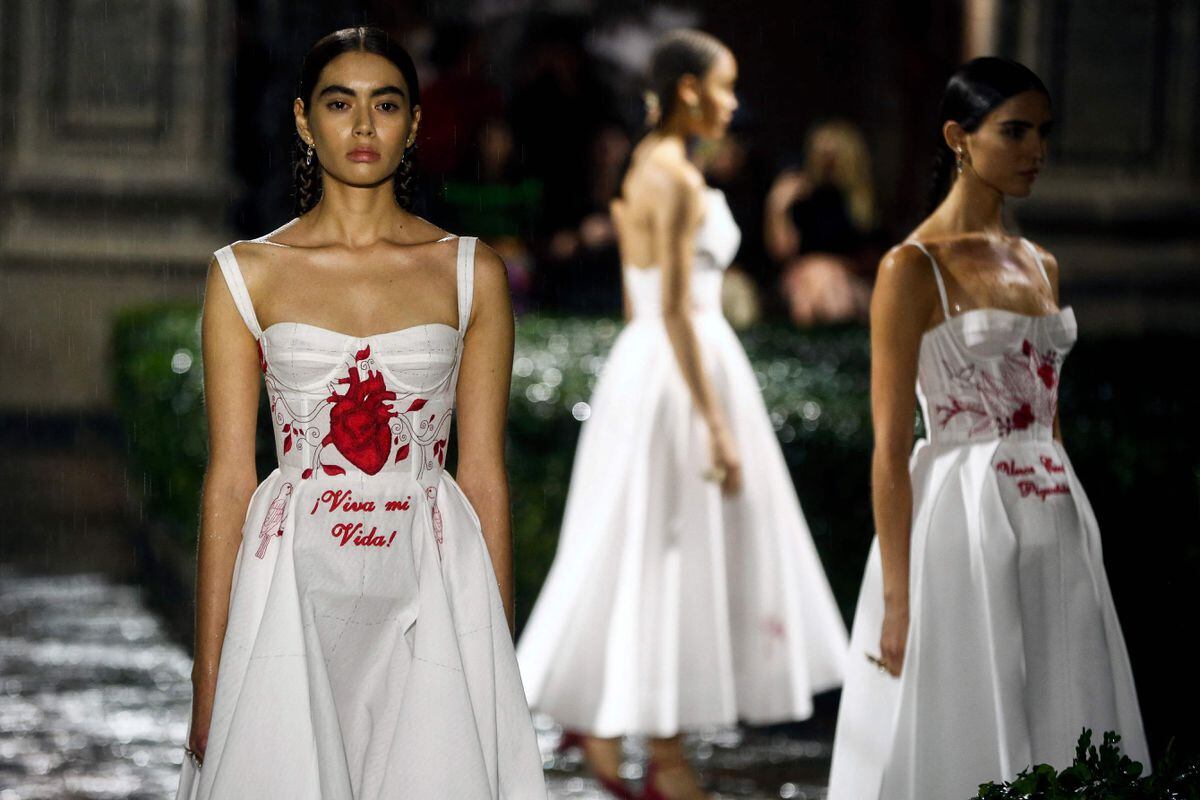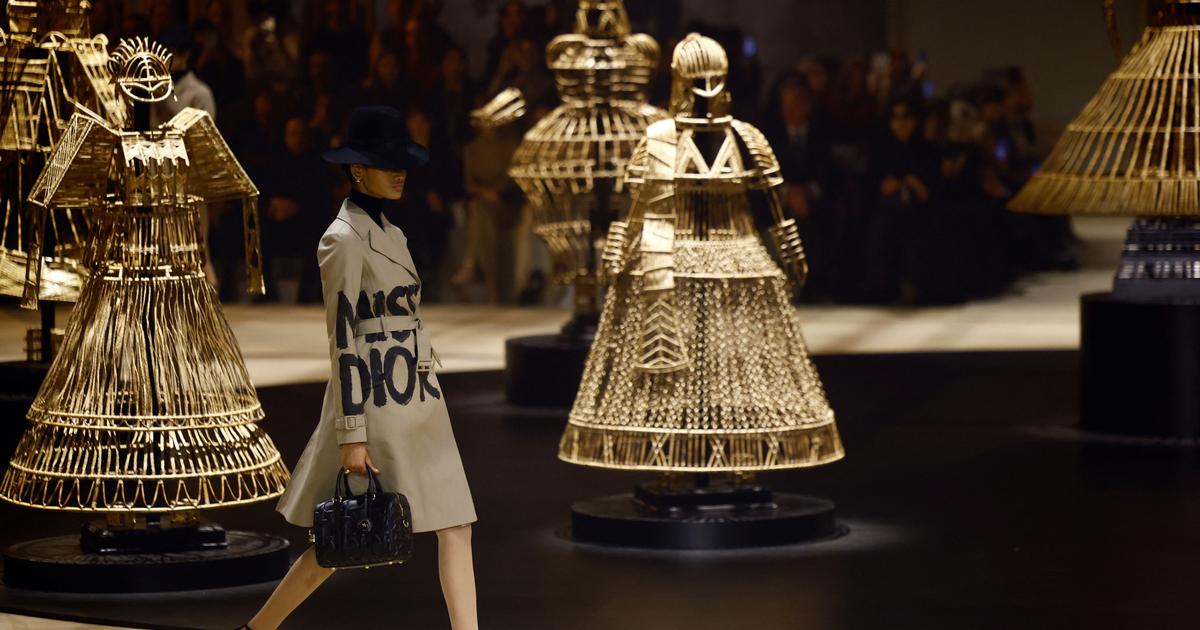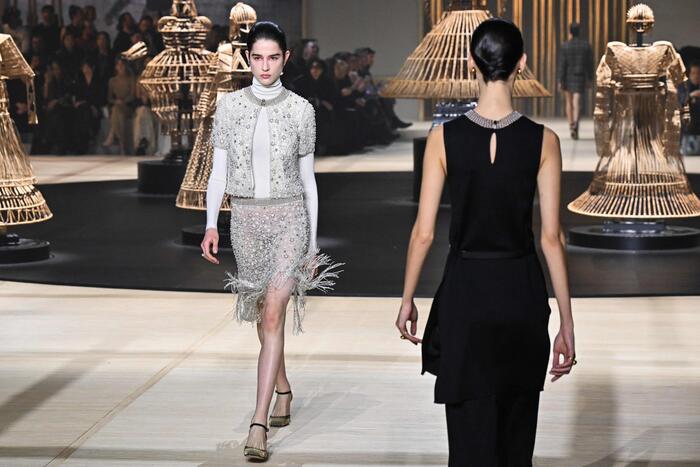This is the web version of Americanas, the newsletter of EL PAÍS América in which it addresses news and ideas with a gender perspective. If you want to subscribe, you can do so at this link.
A group of models dressed in the work of feminist artist Elina Chauvet, made of white suits embroidered in red threads with protest harangues and red shoes went out to the central courtyard of the San Idelfonso school, in Mexico City, to close the parade of Dior's 2024 cruise collection. While the women who paraded were appearing on the rainy patio, the lyrics of the Mexican singer Vivir Quintana flooded the space eerily: "Every minute, every week, they steal our friends, kill our sisters, destroy their bodies, disappear them. Don't forget their names, Mr. President."
A great commotion was generated among the audience, astonished with what had happened in the parade of a house so canonical that it is not expected to mess with political issues. However, when the images of the parade began to rotate publicly, that agitation, that shock of the witnessed scene began to turn into a massive outrage. Could Dior talk about femicides in Mexico? Could this not be an act of visibility, but one of depoliticization of the complex struggles waged by women in these lands? Could the fashion of Maria Grazia Chiuti and the art made by Chauvet do any good to the struggles, also symbolic, of feminism?
Even with the show on the skin, it was necessary to shake off that moment and think without the breaths of the fanciful, with a cool head and with the help of expert voices what the Dior parade had left in the atmosphere. "When I saw the images, and away from the noise of social networks, I remembered that harangue that professes 'The revolution begins with a few accessories!' One that has encouraged movements to make T-shirts, posters, hip-hop music, photographs, and that encourages us to do everything we can to talk about feminism. So, I thought: let's do everything ... except designer catwalks?" said Baby Solís, a cultural manager, commentator and curator of Mexican art.
"I think there is a great prejudice with fashion, which is usually seen as an impure, luxury place, the most superficial, when the art market, for example, is also a luxury market, and works that make very powerful reflections on social realities are part of the market. Teresa Margolles Sierra, is part of the market, Minerva Cuevas, is part of the market. In fact I don't see a big difference between art and fashion, and yet art has been a relevant place to expand social struggles. It seems complex to think that there is a pure place for social protest," says Solís. "Is the catwalk a legitimate place?, maybe not, but the museum is not either, the school either, there are no ideal places, we have an imperfect life, full of contradictions."
For feminist Catalina Ruiz-Navarro, author of the book Las mujeres que lucha se encontro and founder of the feminist magazine Volcanics, it is not that the industry, crossed entirely by capitalism, cannot talk about human rights or feminism. On the contrary, he believes that we should go there, "but the question there is when, how, under what circumstances, what cost does it cost someone to say something," he explains.
"With this parade something very interesting happened. It happened in Mexico City and you have Carlos Slim sitting there in the front row, you have the endorsement of the Government and private enterprise, and then, there, this act of the models with their dresses embroidered with harangues is perfectly lawful, allowed and is wonderful, inspiring and generating conversations, "he says. "The problem is that in this same city, just a few blocks from the school of San Ildefonso, where the parade was held, when women go out to march with the same phrases written on T-shirts or dresses or on a banner, it turns out that they are taken out by force with grenades and violent, repressed. When such phrases appear on an ATM or on a monument, it is condemned, it is said to be belligerent. There is clearly an injustice there," says Ruiz-Navarro.
When the researcher Nelly Lara, from the Center for Gender Studies of the National Autonomous University of Mexico (UNAM) and expert in the crosses between dress and feminism saw the images of the parade, she thought, for her part, of the English author Angela McRobbie, who speaks of postfeminism as the particular way that neoliberalism uses to disseminate a 'supposed feminism'.
"What she warns is that, along with the processes of globalization, feminism reaches new places from which it was erased and with that an ambivalent phenomenon happens: on the one hand, we see that there is an open rejection of feminism as a social movement, we see it when there is a march or a demonstration. there is a rejection in the media of what we do and how we do it," says Lara. "But, also, this ambivalence causes a particular diffusion of an uncommitted feminism, or a light feminism. In this parade I see a simplification of the feminist struggle, the great political struggle that women have made is being erased by a light or commercial feminism, which leads to a profound depoliticization."
The context in which the parade took place undoubtedly took on a leading role in the whole controversy. The Dior show happened in Mexico, in the context of the fourth wave of feminism, at a time when Latin American women are becoming spokespersons for this resistance at a global level. "Precisely because of the political struggles that are taking place at this moment, these cannot be simplified. The struggle goes much deeper. The situation is more complex, so that a brand handles it and, in addition, is linked to one of the most painful issues that we live here in our own flesh, which is femicide, "adds Lara.
What the critics of the parade claim is that if the brands, in this case Dior, had real intentions to work with the victims of femicide in Mexico, if they had wanted to send a true message, the bet would have been different. "If you want to help eradicate femicide, the first thing you have to do is ask women and see what they need. If you ask that question to mothers who have lost their daughters, nobody is going to tell you to give them visibility, because we already have that visibility since they killed six women a day and, now, they kill 11 women, that visibility has not been enough for there to be a change in public policies. Dior didn't go to ask: how can I help? He asked himself and answered: giving visibility, that is the simplest way to help without attending to anything neural. If you want to help you have to start from another place of enunciation, without that kind of conversation, that gesture ends up being completely empty."
From critical fashion studies, that possible scenario of dressing as a place of symbolic disputes does not now appear so clearly as a true platform of political transgression: "Until the past, the narrative was that fashion had a place to break structures, but I feel that we are witnessing a moment of rupture and questioning of that paradigm, of what fashion was supposed to have been able to do," explains Edward Salazar, PhD Latino Studies at the University of California.
"In the framework of capitalism, expecting that there will be a pure action and disconnected from mercantilism is very difficult, and that is why what one can say is that there have been times when communities have used the tools or weapons of the master to at least destabilize the house, but not bring it down. because it has not been possible. So fashion with its small revolutions has transformed anything? It seems not, not entirely, and we are reevaluating that paradigm," Salazar adds.
For Professor Nelly Lara, the malaise is easy to summarize: "As long as women do not own the means of production, brands and capital systems, although our discourse is put there as the axis of sales, riches will hardly reach us, they will hardly help our causes, then this becomes a process of exploitation of women. Feminism is asking itself the big question: How far can we dialogue with the state, which is patriarchal, how far with capitalism?"
Here are our recommended articles of the week:
And to say goodbye, a suggestion:
🚺 An event about women:
This coming Wednesday, May 31, EL PAÍS organizes, together with UN Women and the mayors of Mexico City and Bogotá, the Dialogue of Women in the Americas. The event, which will take place at the National Museum of Anthropology in the Mexican capital, and can be followed virtually on the platforms of this newspaper, has as guests politicians, officials of international organizations, legislators, jurists and representatives of civil organizations to talk about the main challenges of women in the region.
The main table will be moderated by the director of EL PAÍS, Pepa Bueno, who will talk with the Colombian vice president, Francia Márquez and the head of the Government of Mexico City, Claudia Sheinbaum. The second vice president and Minister of Labor of Spain, Yolanda Díaz, and the mayor of Bogotá, Claudia López, will also intervene virtually.









